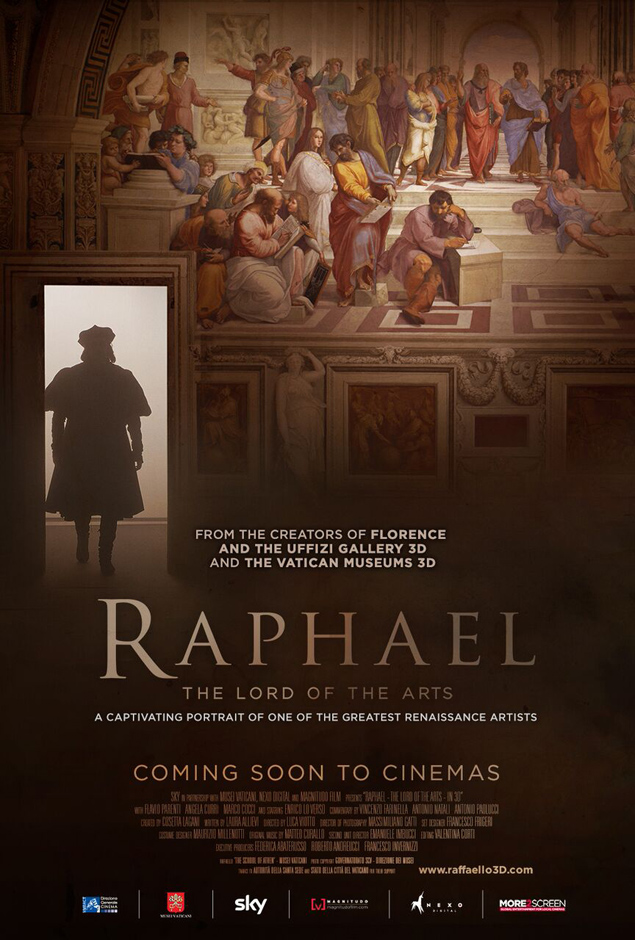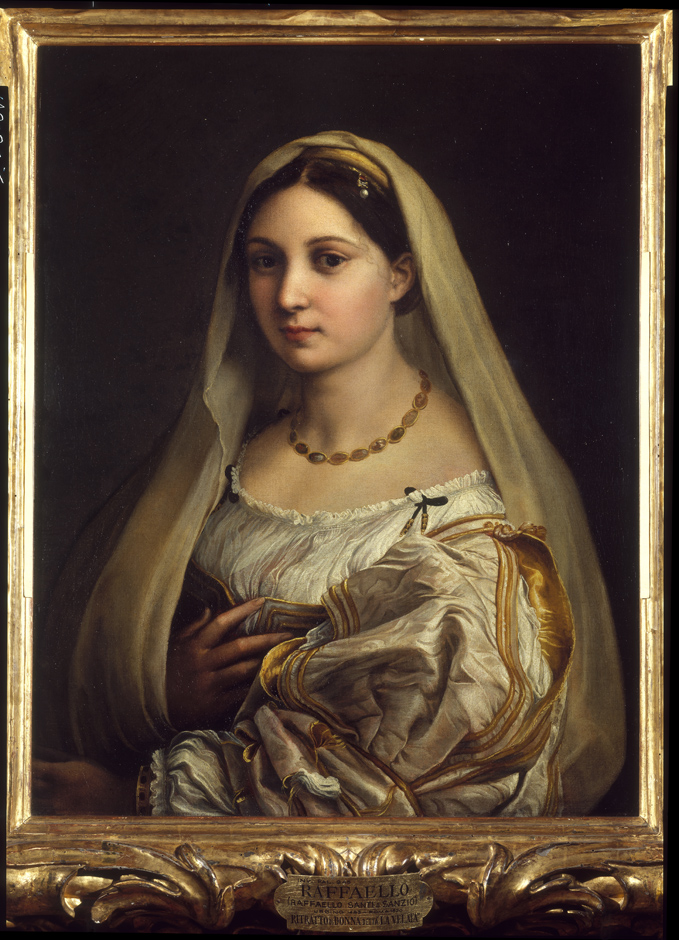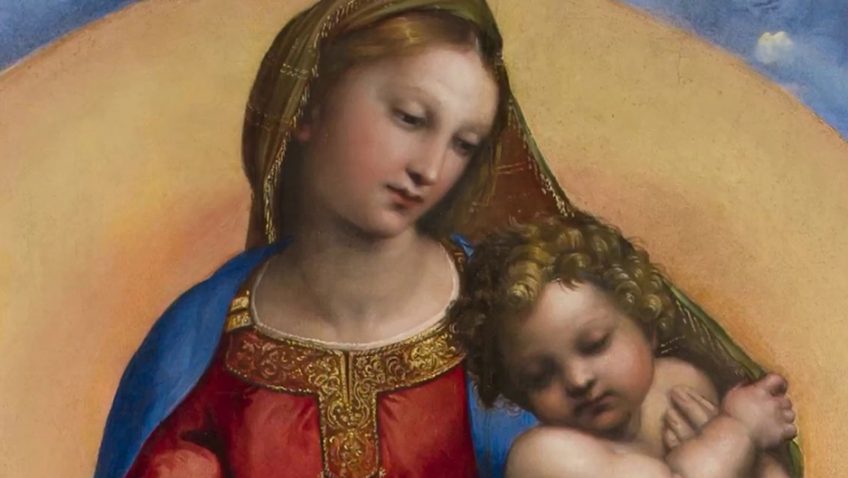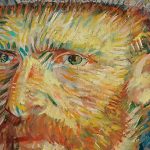Joyce Glasser reviews Raphael – The Lord of the Arts (in selected cinemas, May 23, 2017)
Raphael – The Lord of the Arts is apparently the first biopic of the great Italian Renaissance painter Raffaello Sanzio made specifically for cinema, combining the talking heads of three expert art historians; camera tours of his most famous – and seldom seen – paintings, frescoes and tapestries; excellent contextual analysis of key works; and a few stilted mute historical reenactments that pop and that we could have done without.
 The timing for audiences in the UK couldn’t be better. Orphaned at 11, Raphael was, by the age of 17, a thorn in the side of Sebastiano del Piombo and the great Michelangelo. Until 25 June, you can see that for yourself at the National Gallery’s exhibit entitled Michelangelo & Sebastiano which includes letters between the two artists and collaborators that refer to Raphael and his death (he died on his birthday, 6 April 1520 at the age of 37). While the exhibit obviously focuses on Sebastiano (and, to a lesser extent, Michelangelo), the invisible protagonist is Raphael. Michelangelo disliked him and, it is suggested, explicitly teamed up with Sebastiano to compete with Raphael’s strengths in oil painting and colour.
The timing for audiences in the UK couldn’t be better. Orphaned at 11, Raphael was, by the age of 17, a thorn in the side of Sebastiano del Piombo and the great Michelangelo. Until 25 June, you can see that for yourself at the National Gallery’s exhibit entitled Michelangelo & Sebastiano which includes letters between the two artists and collaborators that refer to Raphael and his death (he died on his birthday, 6 April 1520 at the age of 37). While the exhibit obviously focuses on Sebastiano (and, to a lesser extent, Michelangelo), the invisible protagonist is Raphael. Michelangelo disliked him and, it is suggested, explicitly teamed up with Sebastiano to compete with Raphael’s strengths in oil painting and colour.
That rivalry might have intensified when Michelangelo was finishing the Sistine Chapel in 1512 while Raphael was busy decorating the Stanze rooms a short walk from the Chapel. The rivalry culminated on 20 December, 1519, when Raphael’s extraordinary tapestries of the lives of St Peter and St Paul were displayed for the first time below Michelangelo’s ceiling in the Sistine Chapel. Sebastiano was forever competing with Raphael, even after Raphael’s death, when, despite the hugely influential Michelangelo’s recommendation, Sebastiano lost the contract for the frescoes in the Vatican’s Sala dei Pontefici to Raphael’s workshop.
Unfortunately, the film says nothing about this rivalry, and presents Raphael’s ascendance to the heights Rome’s ‘Prince of Painters’ or Lord of the Arts, as an unimpeded progression. We are told that Raphael idolized Leonardo and Michelangelo and absorbed all of the great art of his day during his formative years.
Raphael’s first teacher was his father, Giovanni Santi, a poet and the court painter of the Duke of Urbino, who instilled in his devoted son a love of all of the arts. Giovanni died when Raphael was 11 (Raphael’s loving mother having died when he was 8), but lived on in Raphael’s art which includes several depictions of his father. Raphael’s second teacher was the great Perugino who is depicted in Raphael’s famous fresco, the School of Athens. The film makes a comparison of the two artists showing how Raphael surpassed his master by painting real people in natural poses, with the anatomical precision and intense emotion Raphael copied from Michelangelo. You can see why Michelangelo was worried. As the sometimes clumsy off-screen commentary adds, ‘The time has come for painting to depict scenes that are less harmonious, but are able to convey strong emotions.’
 Leaving Umbria at 17, Raphael went to Florence where a historical reconstruction shows Leonardo unveiling The Mona Lisa to a bewitched Raphael. We do not know if the comments ascribed to Raphael upon seeing the painting are from his diary or from the often pen of a scriptwriter imaging scenes that never happened. In 1508, when he was 33, Raphael was summoned to Rome by Julius II, where he remained for the rest of his short life and is where he is buried in the Pantheon, a tribute to his celebrity and contribution to Rome’s greatness.
Leaving Umbria at 17, Raphael went to Florence where a historical reconstruction shows Leonardo unveiling The Mona Lisa to a bewitched Raphael. We do not know if the comments ascribed to Raphael upon seeing the painting are from his diary or from the often pen of a scriptwriter imaging scenes that never happened. In 1508, when he was 33, Raphael was summoned to Rome by Julius II, where he remained for the rest of his short life and is where he is buried in the Pantheon, a tribute to his celebrity and contribution to Rome’s greatness.
One of the problems with such biographies is the paucity of personal information on such figures, much of which comes from letters, patrons’ documents or, in the case of Raphael, from Giorgio Vasari (who never met Raphael) whose biography of artists was first published in 1550, thirty years after Raphael’s death.
Fortunately for most of the 90 minute film, shot in 3d and Ultra HD, the art works do the talking and director Luca Viotto takes us on a thrilling Raphael tour. We visit twenty locations including two exclusives: The Vatican Logge and Cardinal Bibbiena’s apartment in the Apostolic Palace.
We also view in detail that would not even be possible to tourists in situ, some 70 works, including the celebrated The Marriage of the Virgin, the Madonna del Cardellino (Goldfinch), the School of Athens (where Plato looks a lot like Leonardo); the breathtaking Sistine Madonna, The Sistine Tapestries and the Transfiguration.
Christ’s face is The Transfiguration is believed to have been the last painted image Raphael saw and worked on before his death. Commissioned by Cardinal Giulio de Medici, the later Pope Clement VII (1523–1534) as an altarpiece for France’s Narbonne Cathedral it ended up for many years in the Louvre where it so impressed Turner that he used it to teach perspective in his lectures. What is not mentioned is that the painting was deemed so important that, as a concession in the Congress of Vienna, France returned the Transfiguration to the Vatican (now in the Pinacoteca).
Three art historians provide intelligent and insightful commentary on many of the frescoes, oil paintings and tapestries – a veritable art history lesson. While their names appear briefly in captions, one of the maddening aspects of the documentary is that the names of the paintings and their locations, as well as proper names, are rattled off in Italian so that these citations are all but meaningless for the average viewer. It would have helped anyone interested in art history or planning a trip to Italy, for the filmmakers to have included a written caption identifying the subject/object of the commentary.
The one exception is a portrait known as La Fornarina (the Baker’s daughter) as her name is pronounced clearly and slowly on several occasions and sounds like it is spelt. The woman in the portrait has been identified with the Margherita Luti, Raphael’s mistress and model in Rome. Vasari does not mention Margherita, but the film includes Vasari’s description of Raphael as a “very amorous man and affectionate towards the ladies.” We are not, however, told of any known offspring.
In selected UK cinemas from 23 May 2017
http://www.more2screen.com/cinema-info-tickets-raphael/ and www.more2screen.com
You can watch the film trailer here:



